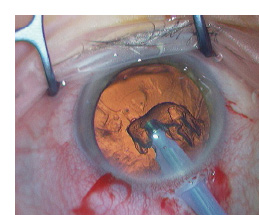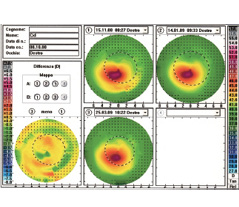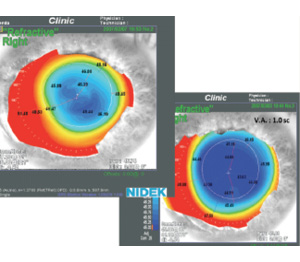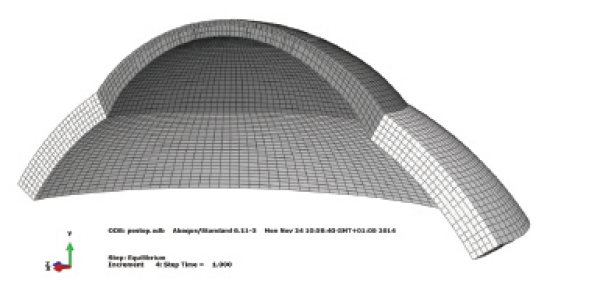2009
February « Surgical Pearls for RLE
By BRIAN LITTLE, MA, DO, FRCS, FRCOphth
Description: Refractive lens exchange requires careful patient selection, comprehensive counseling and adequate chair time, and an exact technique with a low margin for error. The author offers surgical pearls in five areas: incisions, capsulorrhexis, anterior chamber, anterior capsule, and IOL centration.

2011
January « The Future of Corneal Collagen Crosslinking
By ARTHUR B. CUMMINGS, MB ChB, FCS(SA), MMed(Ophth), FRCS(Edin); SHERAZ M. DAYA, MD, FACP, FACS, FRCS(Ed), FRCOphth; A. JOHN KANELLOPOULOS, MD; ANTONIO LECCISOTTI, MD, PhD; MICHAEL MROCHEN, PhD; ROY S. RUBINFELD, MD; THEO SEILER, MD, PhD; ALEKSANDER STOJANOVIC, MD; AND WILLIAM B.TRATTLER, MD
Description: Leaders in CXL recap the history of the technique and explore how it is being used in refractive surgery. They describe their preferred techniques; overview the indications, contraindications, and complications; and discuss rationales for the use of CXL as a standalone and a combined treatment.

2012
February « What Makes a Good Refractive Surgeon?
By GUY SALLET, MD, FEBOphth
Description: The author offers 10 points to help evaluate one’s practice and achieve better refractive results and happier patients. His pointers include understanding the optics of the eye, choosing diagnostic and surgical instruments, dealing with chair time, choosing a surgical technique, treating patients like family, communicating with colleagues, managing complications, performing postoperative care, and understanding the economics of refractive surgery.

May « Appropriate IOL Calculations in Postrefractive Surgery Patients
By ARTHUR B. CUMMINGS, MB ChB, FCS(SA), MMed(Ophth), FRCS(Edin); LAURIE K. BROWN, COMT, OSA, COE, OCS, CPSS; JOHN S.M. CHANG, MD; H. BURKHARD DICK, MD; ERIK L. MERTENS, MD, FEBOphth; AND
KJELL U. SANDVIG, MD, PhD
Description: The number of previous refractive surgery patients now facing cataract surgery continues to grow. Contributors share tips for achieving accuracy in IOL power calculations, including selecting the best formula, customizing the IOL selection, deciphering the causes of previous errors, performing touch-ups, and considering posterior corneal curvature.

2013
June « Epithelial Thickness: An Indicator for Early Keratoconus?
By A. JOHN KANELLOPOULOS, MD; IOANNIS M. ASLANIDES, MD, PhD, MBA, FRCOphth; AND GEORGE ASIMELLIS, PhD
Description: The authors performed a study to examine whether increased epithelial thickness can be an indicator for early keratoconus. Using high-frequency ultrasound biomicroscopy pachymetry, they found that overall epithelial thickness appeared to be increased in ectatic corneas. They suggest that overall average increased epithelial thickness may be an early biomarker of loss of corneal stability.

September « Complications of Small-Pupil Cataract Surgery
By BORIS MALYUGIN, MD, PhD
Description: Many surgical maneuvers used to enlarge small pupils can lead to increased risks of complications. Use of a minimally invasive approach allows the surgeon to minimize the risk of complications and provide patients with the best possible outcomes.

2014
October « My Best Practices for Enhancing the Patient Experience
By ERIK L. MERTENS, MD, FEBOphth
Description: It is vital for ophthalmologists to make the patient experience as stress-free and welcoming as possible. The author describes steps taken at his facility to make the experience pleasant for the patient, including improvements in clinic design, staff education, and the high-tech feel of the practice.

2015
January « A Lifecycle Lens
By MALIK Y. KAHOOK, MD
Description: A modular lens design allows the IOL to be modified throughout the patient’s lifetime depending on his or her refractive needs. The optic element can be uncoupled from the base of the Harmoni IOL System (ClarVista Medical) and exchanged to fit the patient’s lifecycle.

March « Optimization of Surgical Treatments in the Cornea
By HARALD P. STUDER, PhD; AND CYNTHIA J. ROBERTS, PhD
Description: Corneal forces and IOP form a balance that determines the shape of each individual cornea. Predictive modeling taking these forces into account could be used to customize corneal surgery parameters for each specific patient. This approach may one day be important in daily clinical practice for risk assessment, surgical planning, and outcomes prediction.

March « AHow Corneal Biomechanics Matters in Optimizing Refractive Surgery
By DDAN Z. REINSTEIN, MD, MA(CANTAB), FRCSC, DABO, FRCOphth, FEBO
Description: Significant variability between patients in how the cornea reacts after laser refractive surgery can be explained only by variability in corneal biomechanics. The ability to make 3-D maps of the biomechanical properties of the cornea in vivo, combined with finite element models, would allow truly customized corneal refractive surgery and provide another method for keratoconus screening.

April « Management of Subluxated Cataracts
BY ARUP BHAUMIK, MD; AND SANTANU MITRA, MBBS, DOMS
Description: A subluxated lens increases the complexity of cataract surgery. The technique to be used depends on the degree of zonulopathy and its underlying origin. A number of tools are available to assist in surgery for a subluxated lens, including capsular tension rings and segments, iris hooks, and capsular hooks.

April « Future Perspectives in SMILE, LASIK and PRK, and Phakic IOLs
BY MARCUS BLUM, MD; MASSIMO BUSIN, MD; AND ALAA EL-DANASOURY, MD
Description: Surgeons discuss pros and cons of refractive surgical approaches. They note that small incision lenticule extraction (SMILE) is a promising technique with good reported visual outcomes, predictability, and safety; still, LASIK will remain the dominant corneal procedure for the near future. Phakic IOLs offer a lenticular alternative to corneal refractive surgical techniques.

April « Whatever Happened to LASIK (Volumes)?
BY SHERAZ M. DAYA, MD, FACP, FACS, FRCS(Ed), FRCOphth
Description: LASIK volumes have not rebounded after the recession of the previous decade, despite high levels of patient satisfaction. Commoditization of the procedure has caused it to lose its luster among many prospective patients. Surgeons must treat LASIK with renewed respect and provide each patient with the best available care in order to improve the public perception of LASIK.

May « Prophylactic Treatments Against CME After Cataract Surgery
BY RUDY M.M.A. NUIJTS, MD, PhD; ROB W.P. SIMONS, BSc; LAURA H.P. WIELDERS, MD; FRANK J.H.M. VAN DEN BIGGELAAR, PhD; BJORN WINKENS, PhD; AND JAN S.A.G. SCHOUTEN, MD, PhD
Description: Cystoid macular edema (CME) is a common complication that can affect visual acuity after cataract surgery. The authors describe the international multicenter PREMED study, which aims to provide conclusive evidence for a method to prevent CME after cataract surgery in diabetic and nondiabetic patients. The results were expected to be announced in 2016.

May «A Novel Method of Objective Testing in DED
By DENNIS P. HAN, MD; AND TEODORO EVANS, MD
Description: Proceeding to cataract surgery without considering the retina is like driving into an unfamiliar city without knowing the route, the authors say. Their pearls include knowing what retinal problems to prevent and how to prevent them, understanding that macular disease can affect IOL choice, and being aware of the technical challenges in postvitrectomy patients.

October « The
Evolution of the Capsulotomy
By RICHARD PACKARD, MD, FRCS, FRCOphth
Description: Methods of opening the lens capsule have evolved over more than 250 years. Dr. Packard’s Binkhorst Lecture, and his article, trace this evolution from Daviel’s crude openings in the 18th century to today’s precise capsulorrhexis and laser capsulotomy techniques.

2016
May « Building Strategic Alliances That Work
By GREGORY D. PARKHURST, MD, FACS
Description: A strategic alliance is a cooperation between two or more entities working toward a common objective. Strategic alliances can provide benefits to those involved by reducing costs, distributing risks, facilitating the testing of new strategies, encouraging innovation, and broadening customer bases, all of which can accelerate practice growth.

May « Leaders Are Dealers in Hope
By SHERAZ M. DAYA, MD, FACP, FACS, FRCS(Ed), FRCOphth
Description: In order to deliver outstanding care to patients, ophthalmologists need the assistance of a team including nurses, technicians, receptionists, administrators, and finance staff. The doctor should provide this team with direction that aligns with his or her own personal values and principles. Leadership requires conveying one’s philosophy to staff members so they can carry out the goals of the team.

July/August « The Surgeons Down the Street May Not be Your Competition
By GUY M. KEZIRIAN, MD, MBA, FACS
Description: Refractive surgeons located in your area who provide good quality refractive surgery are not your competition. They are your social proof. That is, for a generation that relies on crowdsourcing for information, the more happy refractive surgery patients there are, the better for all refractive surgeons. If public confidence in refractive surgery grows, so will practices

July/August « Top 10 Ways to Grow Your LASIK Volume
BY GREGORY D. PARKHURST, MD, FACS
Description: The author offers tips for growing LASIK volume, including marketing your practice based on patient benefits, not one particular procedure; not advertising price, but rather touting the financial benefits of undergoing LASIK; and hiring people who can relate to the elective refractive surgery demographic.



